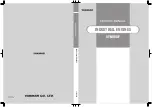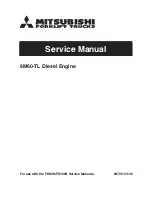
ENGLISH
15
Carburetor Modifications for High Altitude Operation
At high altitude, the standard carburetor air-fuel mixture will be too rich.
Performance will decrease, and fuel consumption will increase. A very
rich mixture will also foul the spark plug and cause hard starting.
Operation at an altitude that differs from that at which this engine was
certified, for extended periods of time, may increase emissions.
High altitude performance can be improved by specific modifications to
the carburetor. If you always operate your engine at altitudes above
610 meters (2,000 feet), have your servicing dealer perform this
carburetor modification. This engine, when operated at high altitude
with the carburetor modifications for high altitude use, will meet each
emission standard throughout its useful life.
Even with carburetor modification, engine horsepower will decrease
about 3.5% for each 300 meter (1,000 foot) increase in altitude. The effect
of altitude on horsepower will be greater than this if no carburetor
modification is made.
When the carburetor has been modified for high altitude operation, the air-
fuel mixture will be too lean for low altitude use. Operation at altitudes below
610 meters (2,000 feet) with a modified carburetor may cause the engine to
overheat and result in serious engine damage. For use at low altitudes, have
your servicing dealer return the carburetor to original factory specifications.
Emission Control System Information
Emission Control System Warranty
Your new Honda complies with both the U.S. EPA and State of California
emission regulations. American Honda provides the same emission
warranty coverage for Honda Power Equipment engines sold in all 50
states. In all areas of the United States, your Honda Power Equipment
engine is designed, built, and equipped to meet the U.S. EPA and
California Air Resources Board emission standard for spark ignited
engines.
Warranty Coverage
Honda Power Equipment engines certified to CARB and U.S. EPA
regulations are covered by this warranty to be free from defects in
materials and workmanship that may keep it from meeting the
applicable U.S. EPA and CARB emissions requirements for a minimum of
2 years or the length of the
Honda Power Equipment Distributor’s Limited
Warranty
, whichever is longer, from the original date of delivery to the
retail purchaser. This warranty is transferable to each subsequent
purchaser for the duration of the warranty period.
Warranty repairs will be made without charge for diagnosis, parts, and
labor. Information about how to make a warranty claim, as well as a
description of how a claim can be made and/ or how service can be
provided, can be obtained by contacting an authorized Honda Power
Equipment dealer or by contacting American Honda at the following:
Email: [email protected]
Telephone: (888) 888-3139
The covered components include all components whose failure would
increase an engine's emissions of any regulated pollutant or evaporative
emissions. A list of specific components can be found in the separately
included emissions warranty statement.
Specific warranty terms, coverage, limitations and manner of seeking
warranty service are also set forth in the separately included emissions
warranty statement. In addition, the emissions warranty statement can
also be found on the Honda Power equipment website or at the
following link:
http://powerequipment.honda.com/support/warranty
Source of Emissions
The combustion process produces carbon monoxide, oxides of nitrogen,
and hydrocarbons. Control of hydrocarbons and oxides of nitrogen are
very important because, under certain conditions, they react to form
photochemical smog when subjected to sunlight.
Carbon monoxide does not react in the same way, but it is toxic.
Honda utilizes appropriate air/fuel ratios and other emissions control
systems to reduce the emissions of carbon monoxide, oxides of nitrogen,
and hydrocarbons.
Additionally, Honda fuel systems utilize components and control
technologies to reduce evaporative emissions.
The U.S. and California Clean Air Acts, and Environment and Climate
Change Canada (ECCC)
U.S. EPA, California and Canadian regulations require all manufacturers to
furnish written instructions describing the operation and maintenance of
emission control systems.
The following instructions and procedures must be followed in order to
keep the Honda engine emissions within the emission standards.
Tampering and Altering
Tampering is a violation of federal and California law.
Tampering with or altering the emission control system may increase
emissions beyond the legal limit. Among those acts that constitute
tampering are:
• Removal or alteration of any part of the intake, fuel, or exhaust systems.
• Altering or defeating the governor linkage or speed-adjusting
mechanism to cause the engine to operate outside its design
parameters.
Problems That May Affect Emissions
If you are aware of any of the following symptoms, have your engine
inspected and repaired by your servicing dealer.
• Hard starting or stalling after starting.
• Rough idle.
• Misfiring or backfiring under load.
• Afterburning (backfiring).
• Black exhaust smoke or high fuel consumption.
37Z0A6000.fm 15 ページ 2020年4月27日 月曜日 午後1時34分
















































